Book of Mormon Stylometry — Three Voice Hypothesis — L Voice
This is the fourth in a series of posts looking at stylometry in the Book of Mormon. This post will define the L Voice of the Book of Mormon Three Voice Hypothesis, based on computer wordprint analysis of BOM text. The Book of Mormon Three Voice Hypothesis is that the Book of Mormon has three distinct voices: N (Narrative), S (Sermon), and L (Late). This post will focus on explaining the L Voice.
The first three posts in the series:
Introduction to the Book of Mormon Three Voice Hypothesis
Definition of the N Voice and comparison to S Voice
Deeper Analysis of the S Voice
Background on the L Voice Discovery
My initial hypothesis was that the Book of Mormon could be divided into the sermon S Voice and narrative N Voice, and that this would adequately address many of the observations that the Book of Mormon seems to have distinct voices. I split out the Book of Mormon between S and N, (see prior posts for methodology) and what I discovered was that many of the distinctive qualities were very strong for the first half of the BOM but then started to erode a bit. New vocabulary, phrases, and themes. Charting this out, I found typically the trend started about the start of Helaman and then ramped up, maximizing in Nephi’s writings. After more analysis, I developed the Three Voice Hypothesis, which is that the first split is between S and N, but then the L Voice comes in midway through the book, making three distinct voices in the BOM. The seperation that marks the beginning of L Voice is somewhat arbitrary. I’m choosing the beginning of Helaman to define it, but for various elements it seems to start anywhere between Alma 52 and about 3 Nephi 5.
This is best illustrated by a four quadrant display. There are two major trends S-N, which endure throughout the book, but weakens after Samuel the Lamanite’s S Voice insertion. The other major trend is O Voice (Original) vs L Voice (Late). S and N are very distinct in the first half portion, and the S and N blend together in L, so I call this the Three Voice Hypothesis of N,S, and L.
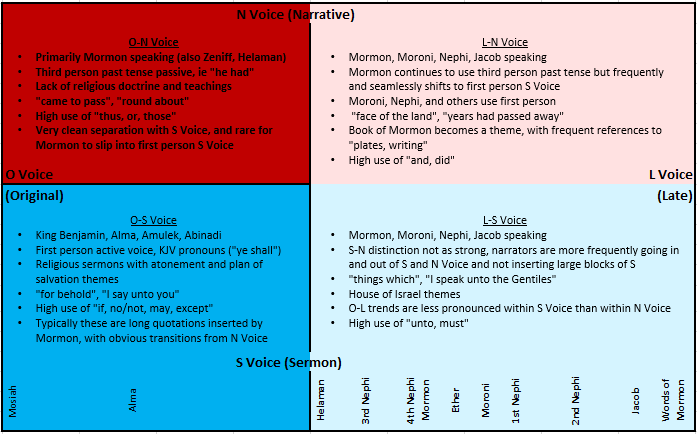
L Voice Writers-Speakers
I use the Book of Helaman as the start of the L Voice, but with some phrases, it seems to start more like Alma 50ish. This covers Mormon, the narrator and Mormon speaking first person, which he does more often, starting in Helaman. It covers the Savior’s visit to America in Third Nephi. It also covers Moroni narrating the Jaredites story, and Moroni’s insertion of letters from his father, and his preaching and narrating of his own story. Going in Mosiah priority order (the order the BOM was translated), we then start over with Nephi telling of his story, we have Lehi’s voice with Nephi quoting his father for long passages, Jacob’s preaching in 2nd Nephi, and Nephi’s preaching at the end of 2 Nephi. Then Jacob’s narration and preaching, Enos, and then the minor record keepers Omni, Chemish, etc, and then ending with Words of Mormon. I exclude all of the Isaiah chapters and other chapter length quotations, such as Matthew and Malachi.
The hypothesis here is that these voices can best be described as 1) the S and N voice which carries over from the first half of the Book of Mormon 2) combining the S and N with the L voice which starts midway through the book and ramps up, becoming maximized with Nephi.
House of Israel Themes
One of the most striking examples of the L Voice is the prominence of ‘House of Israel’ themes. Especially related to BOM writers speaking to or about future Jews and Gentiles. This chart represents frequencies for the following words/phrases:
Gentile, Gentiles, house of Jacob, Israel, Jew, Jews, Judah, tribe, tribes, Zion
Chart explanation:
The bars are frequencies of the specified word/phrase covering blocks of 2,000 words starting from Mosiah in Mosiah Priority order. The top chart is for all. The second chart is just the N (narrative) Voice isolated. The third chart is just the S Voice (sermon) isolated.
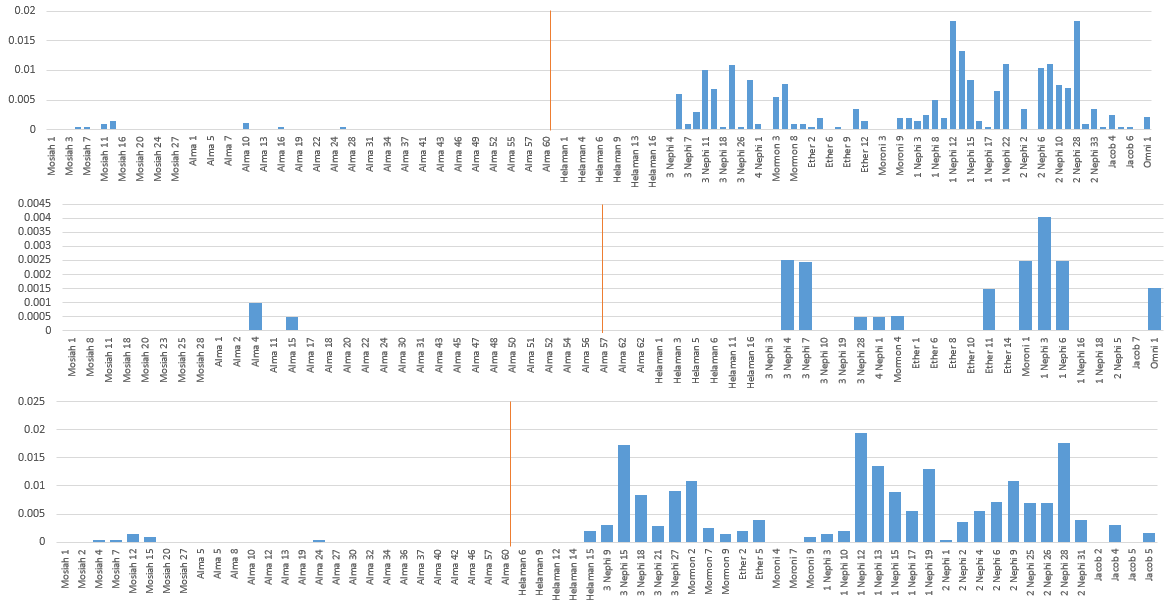

This trend goes across L Voice speakers, but is nearly nonexistent in the first half of the book:
3 Nephi 21:6 Jesus Christ speaking:
For thus it behooveth the Father that it should come forth from the Gentiles, that he may show forth his power unto the Gentiles, for this cause that the Gentiles, if they will not harden their hearts, that they may repent and come unto me and be baptized in my name and know of the true points of my doctrine, that they may be numbered among my people, O house of Israel;
Mormon 5:10 Mormon speaking:
And now behold, this I speak unto their seed, and also to the Gentiles who have care for the house of Israel, that realize and know from whence their blessings come.
Ether 12:22 Moroni speaking:
And it is by faith that my fathers have obtained the promise that these things should come unto their brethren through the Gentiles; therefore the Lord hath commanded me, yea, even Jesus Christ.
1 Nephi 14:1 Angel speaking to Nephi:
And it shall come to pass, that if the Gentiles shall hearken unto the Lamb of God in that day that he shall manifest himself unto them in word, and also in power, in very deed, unto the taking away of their stumbling blocks–
1 Nephi 22:9 Nephi speaking:
And it shall also be of worth unto the Gentiles; and not only unto the Gentiles but unto all the house of Israel, unto the making known of the covenants of the Father of heaven unto Abraham, saying: In thy seed shall all the kindreds of the earth be blessed.
Jacob 4:15 Jacob speaking:
And now I, Jacob, am led on by the Spirit unto prophesying; for I perceive by the workings of the Spirit which is in me, that by the stumbling of the Jews they will reject the stone upon which they might build and have safe foundation.
Omni 1:26 Amaleki speaking:
And now, my beloved brethren, I would that ye should come unto Christ, who is the Holy One of Israel, and partake of his salvation, and the power of his redemption. Yea, come unto him, and offer your whole souls as an offering unto him, and continue in fasting and praying, and endure to the end; and as the Lord liveth ye will be saved.
Early Modern English trends
The most important work going on the last few years in understanding the Book of Mormon text, is that of Royal Skousen and Stanford Carmack’s, identifying Early Modern English grammar, vocabulary, and phrases in the Book of Mormon. The King James Bible was translated into Early Modern English in 1611, and the Book of Mormon is written in the same style. Some modern readers assume the BOM sounds old because Joseph Smith lived 200 years ago, naturally it would sound old. But the BOM also sounded old to its readers when it first came out in 1830. Believers will say that God either directly gave Joseph this language or that he inspired him to use it, in order for it to fit together with the Bible. Critics will say that Joseph mimicked the ‘ancient style’ in order to give the book credibility. Skousen and Carmack have a fascinating new theory that the Book of Mormon was actually translated during the Early Modern English (EModE) era of 1600’s, and that translation was then given to Joseph through the seerstone. They believe that the usage of EModE is done in a way that would have been impossible for someone in Joseph’s time to fake.
One of the things I noticed in my data analysis of Book of Mormon vocabulary trends was that many of of the examples Skousen and Carmack use to make their case, seem to trend higher with L Voice. This area needs a lot more investigation, but here are some initial findings.
Did X
This is a chart of the frequency of the phrase did + verb. ie did go, did eat, did march, did join, did come, etc. The frequency pattern that is most interesting here is by isolating the N Voice in the second chart, since this pattern rarely occurs in the S Voice third chart.
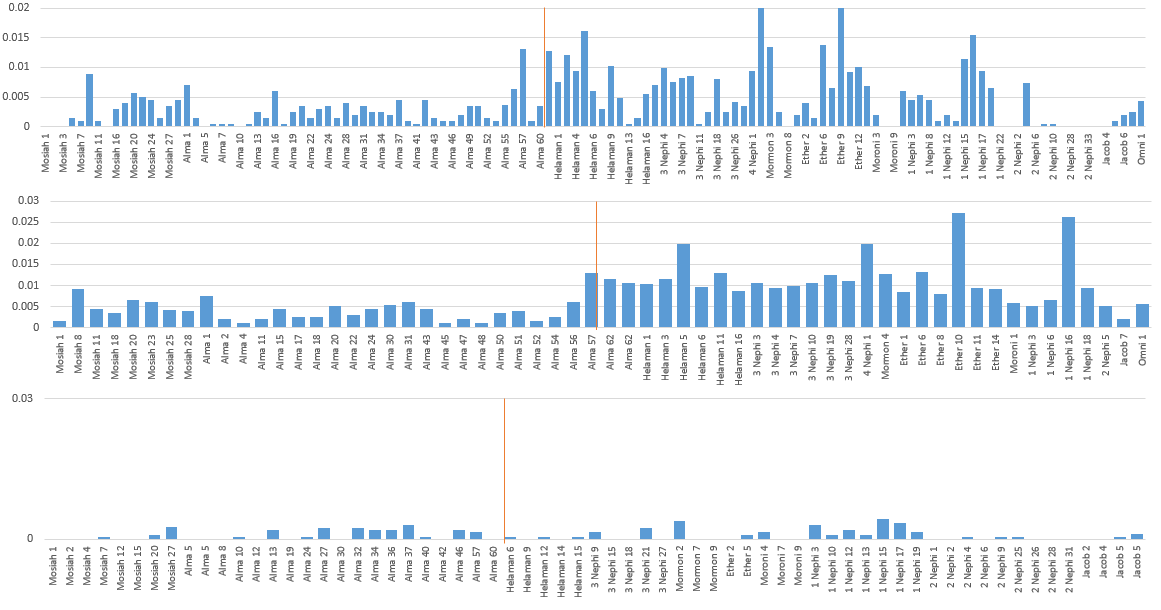

More part
Another EModE grammatical element appearing in the BOM is ‘more part’ with meaning of ‘the majority’.
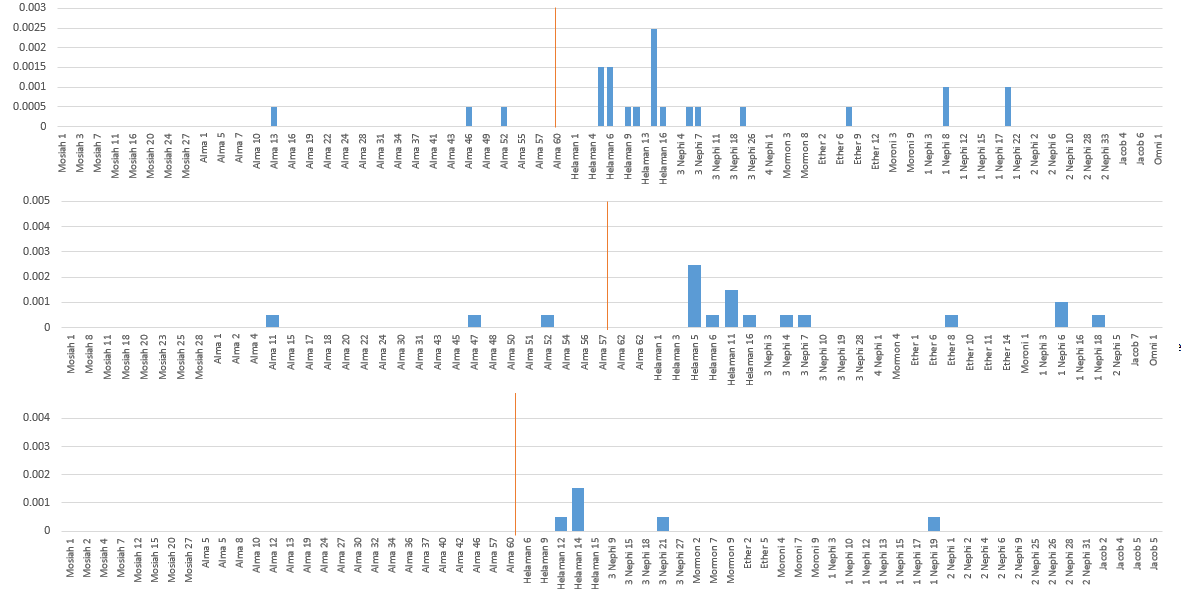

Save it be, Save it were
This is a fascinating phrase of text to me. This phrase was extremely rare in Joseph’s time. In fact, if you do a google advanced book search for this phrase before 1830, you find virtually nothing. There are some clues that are leading me to believe the S and N Voices are created by the same author (translator?), and this is a major one. I will get more into this in a future post.
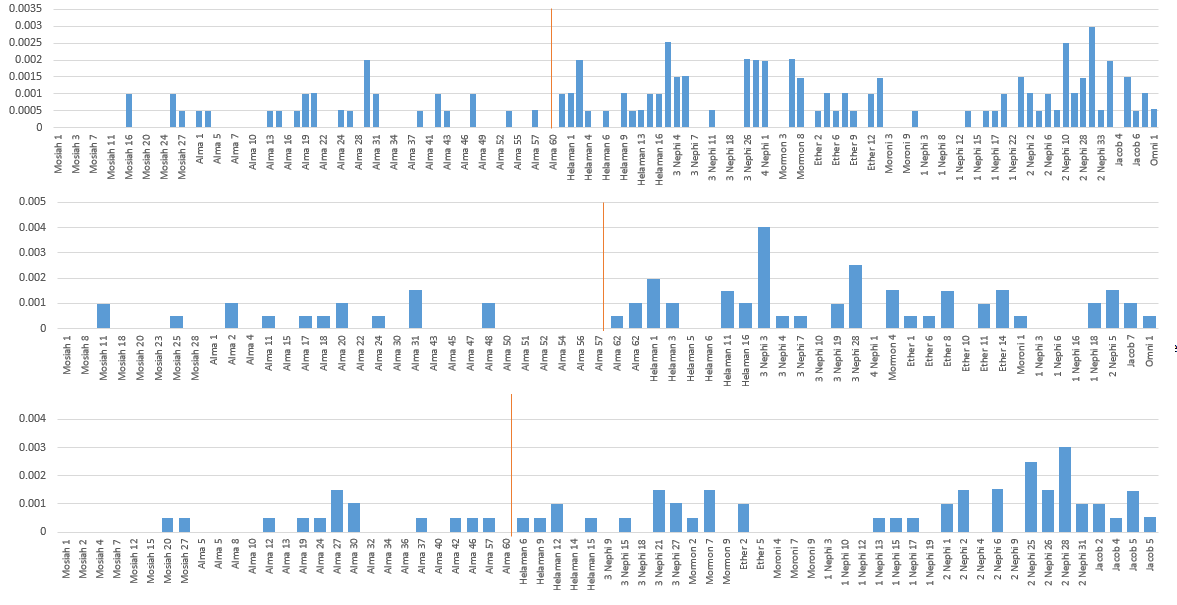

Caused
Here’s an example that goes the opposite direction. This form of grammar, ie ‘he caused that’, seems to fall out of favor in the Book of Mormon in the L Voice.
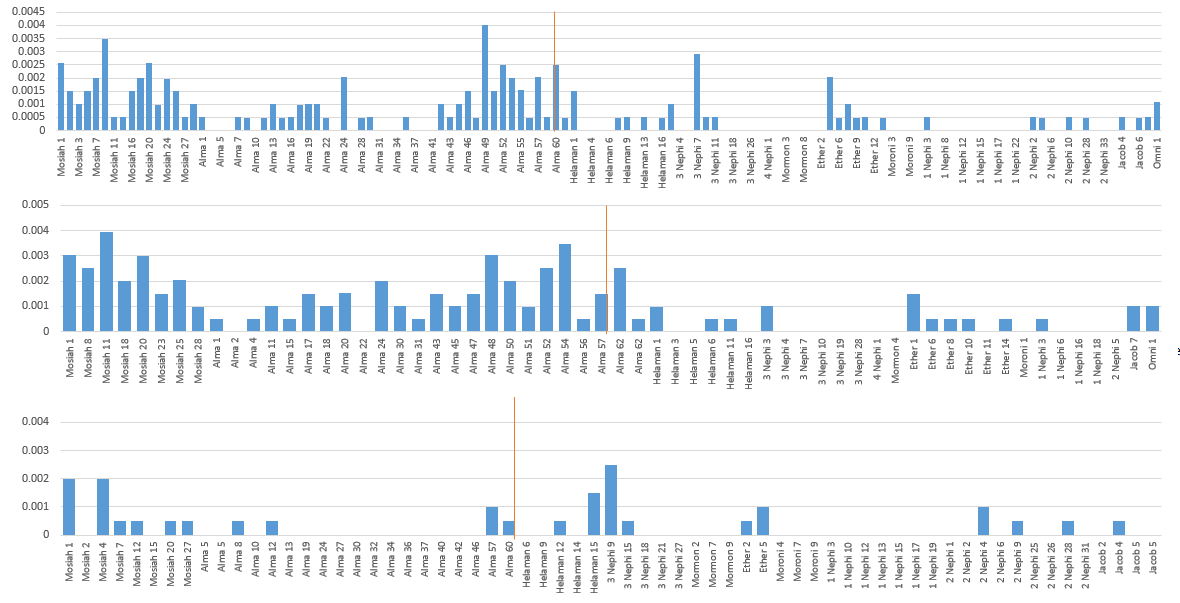

Usage charts for selected words and phrases:
‘I, X’ ie ‘I, Alma’, ‘I, Mormon’, ‘I, Moroni’, ‘I, Nephi’


‘by the power’
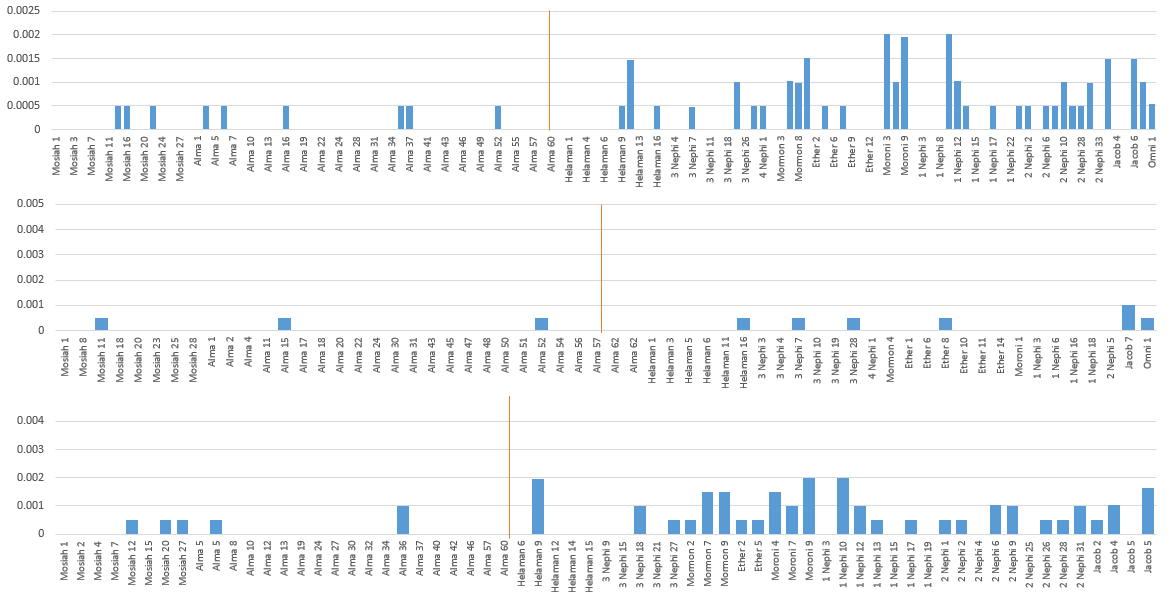

‘must’


‘things which’
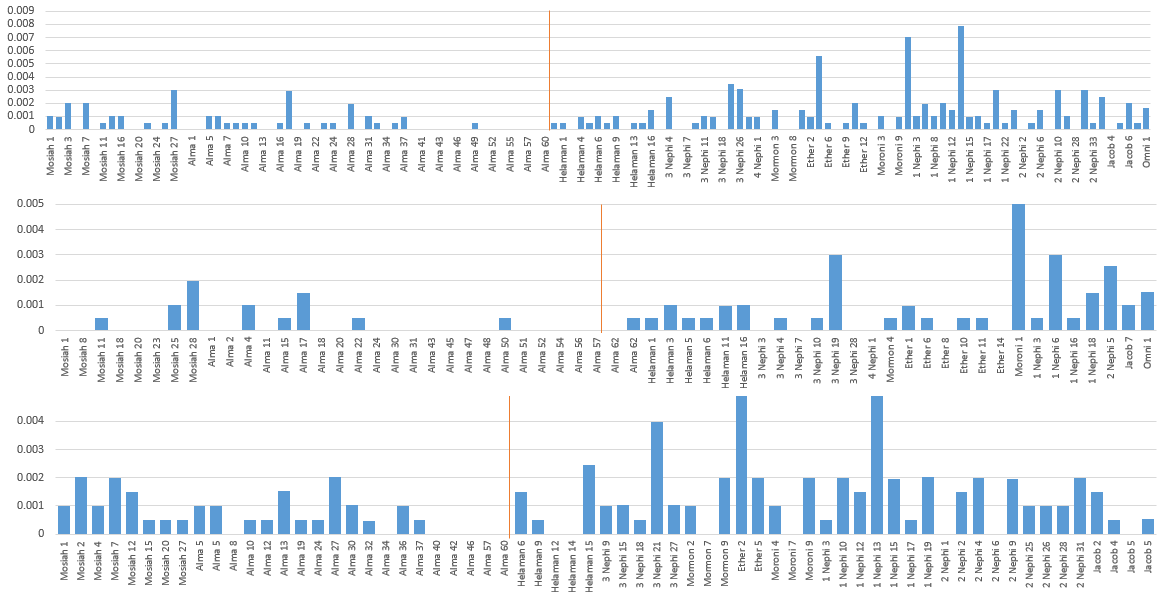

‘hath’
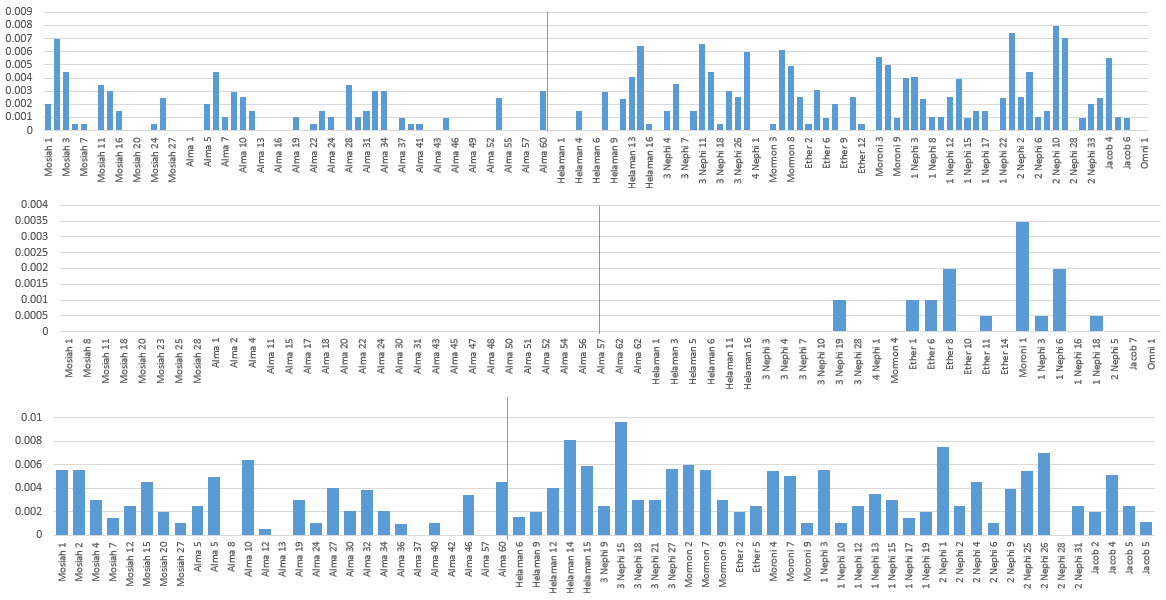

‘passed away’
This is generally used in the context of narration, ‘seventy years had passed away’.
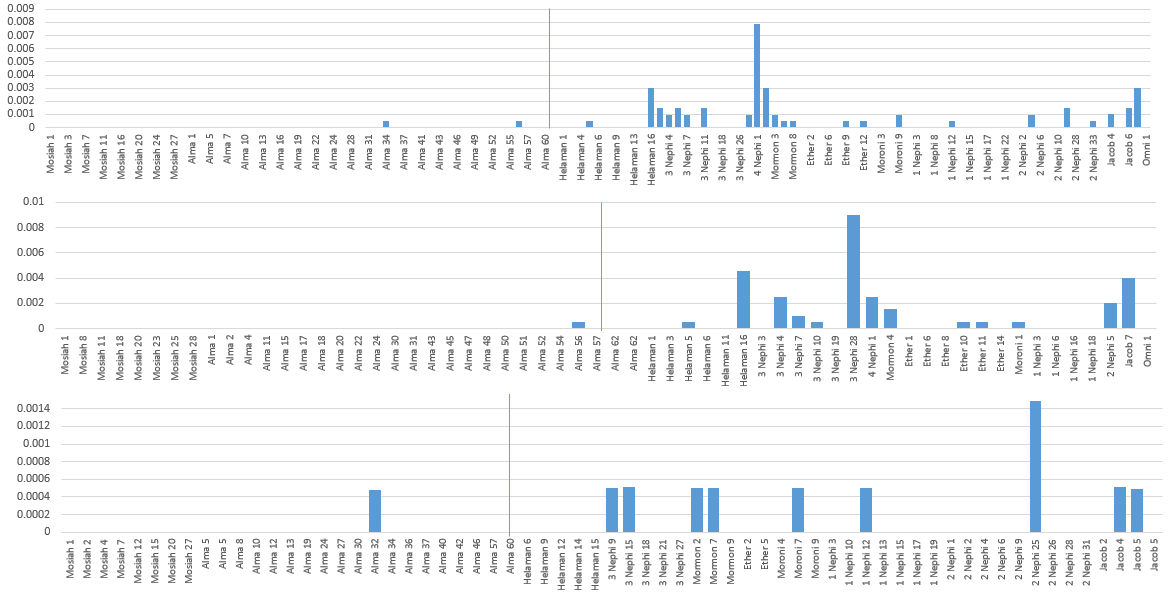

‘write’
The Book of Mormon as a topic suddently starts becoming a major theme starting the beginning of 3rd Nephi. A lot of references to what the authors feel compelled to write. References to the plates. Addressing the audience and how the Book of Mormon will be received.
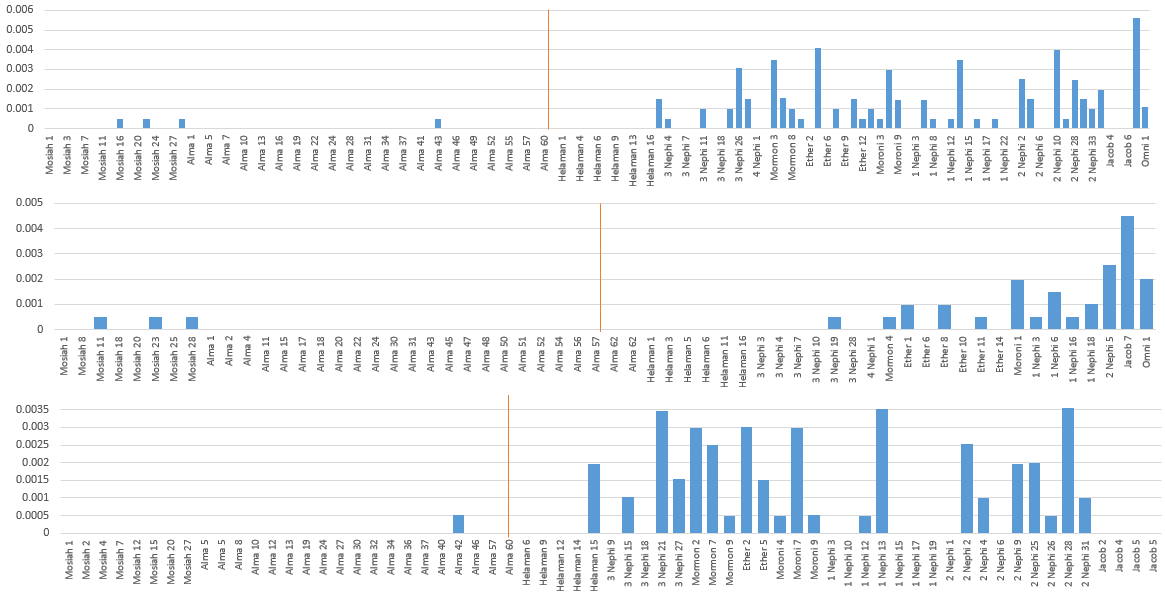

‘Holy Ghost’
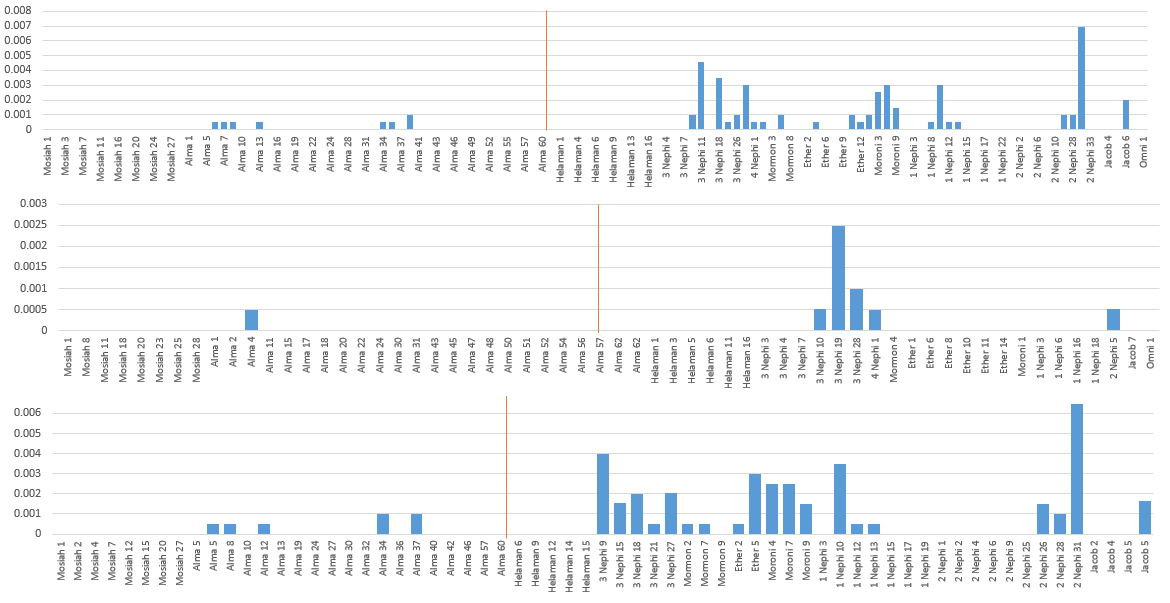

‘like unto’
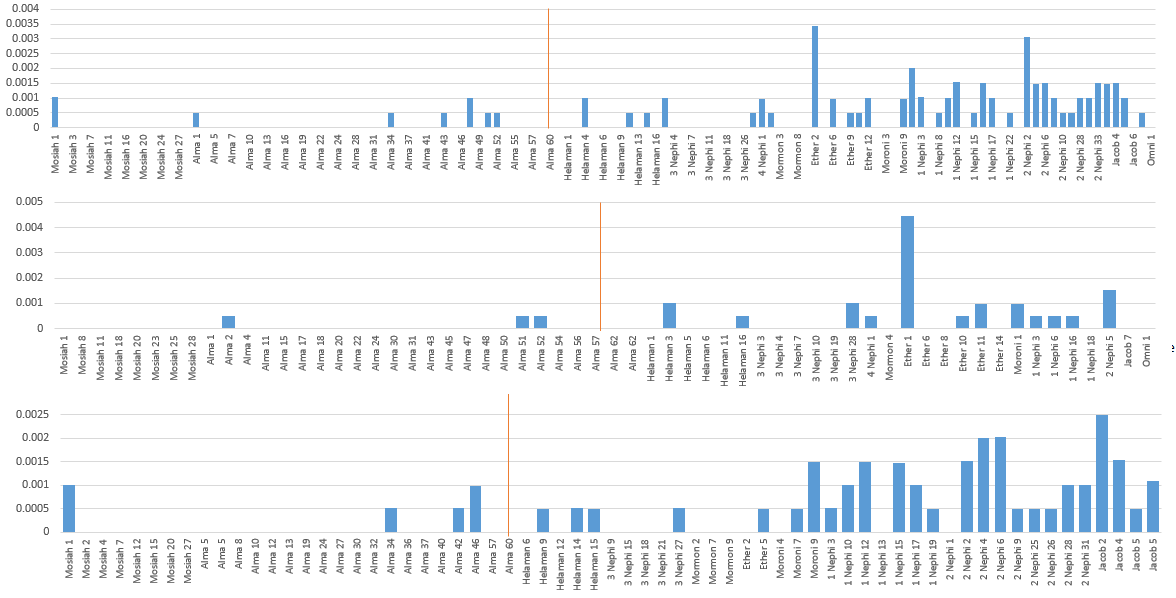

‘the face’ (typically the ‘face of the land’ or ‘the face of this land’)
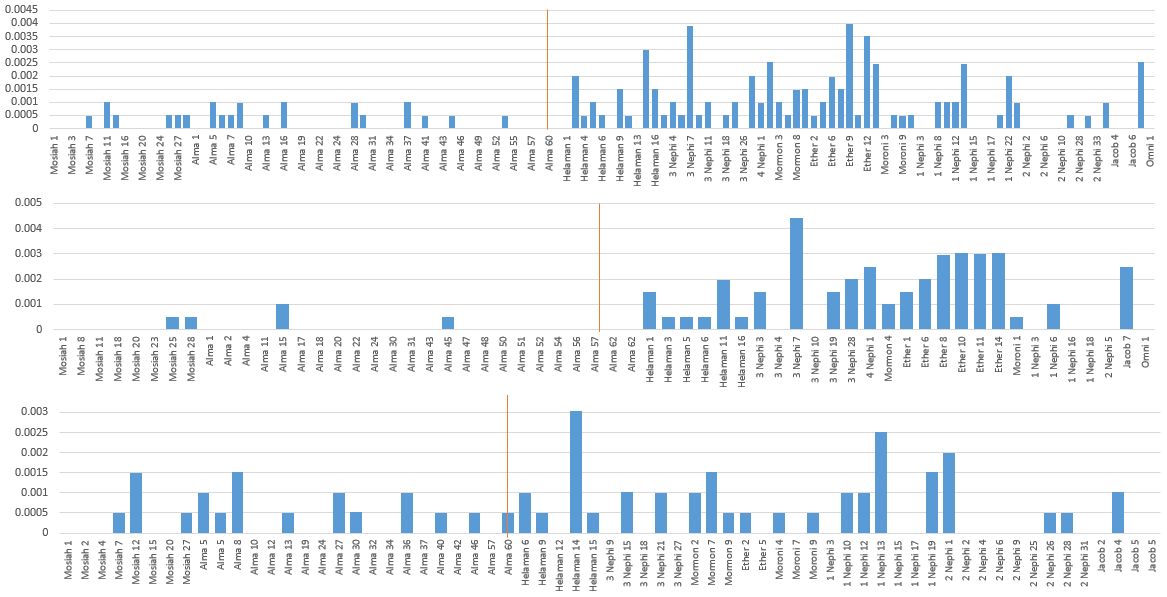

In addition to new words and phrases being used or being used in higher frequencies, the L Voice is also marked by a dropping off or lack of preference for certain words and phrases.
‘thus’
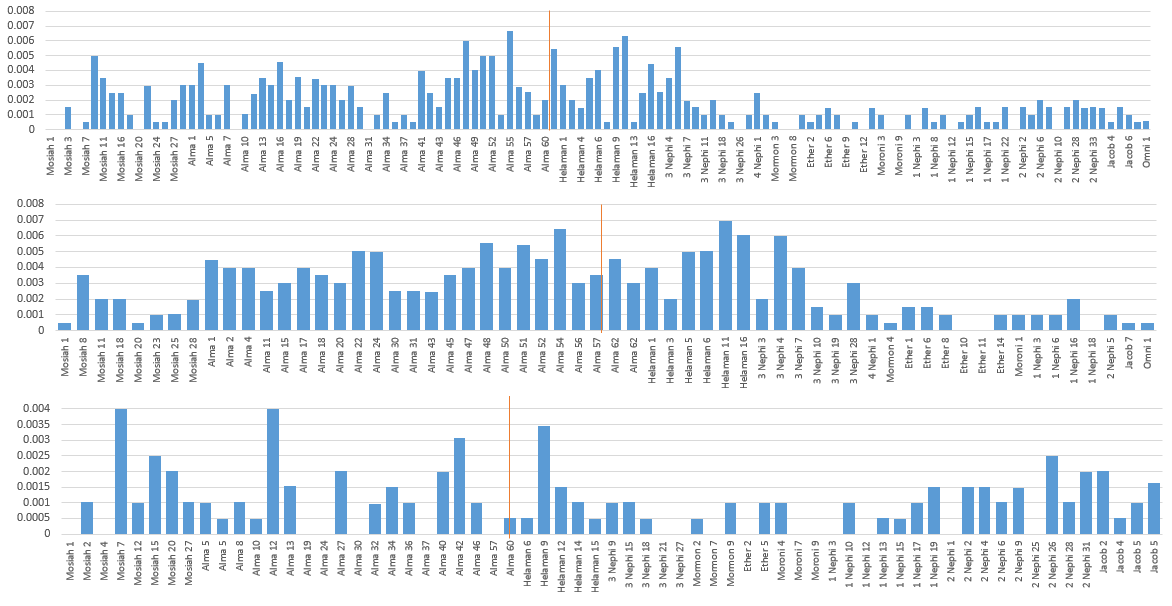

‘or’
This is a very interesting one, especially related to ‘Hebraisms’ in the text. Grammar clauses using the word ‘or’ have been argued as evidence of Hebraisms in the Book of Mormon, ie Hebrew forms of grammar and poetry that are evidence of the book’s roots in the ancient Near East. This area needs more investigation also, but my initial analysis is that the common Hebraisms that occur in the Book of Mormon (like chiasmus, for example), are heavily weighted to the first half of the book (Mosiah priority order).
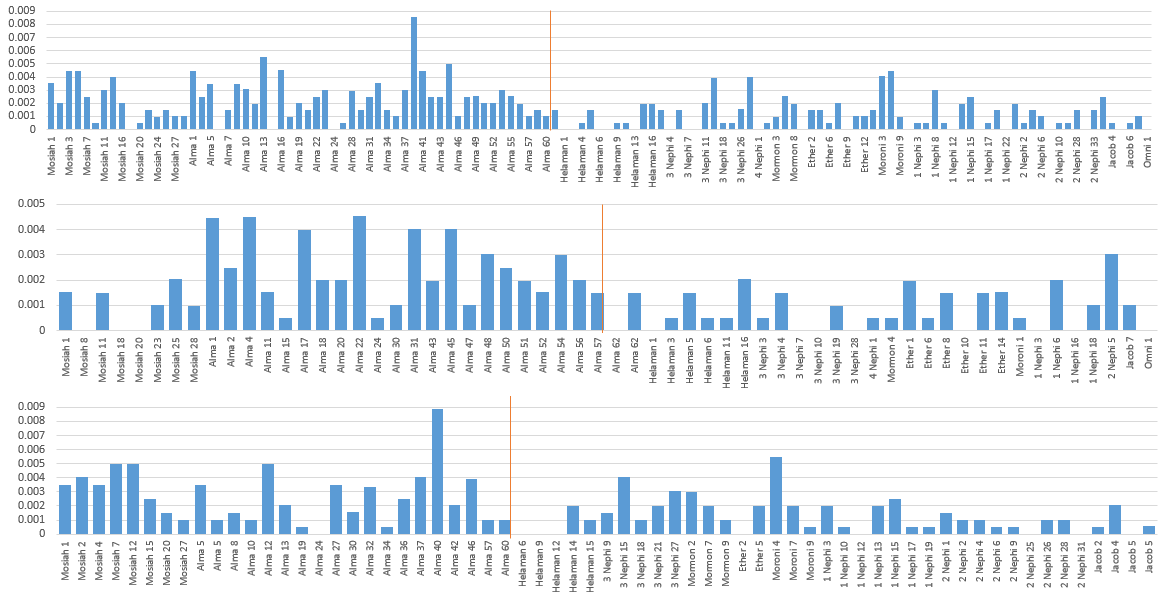

‘now’
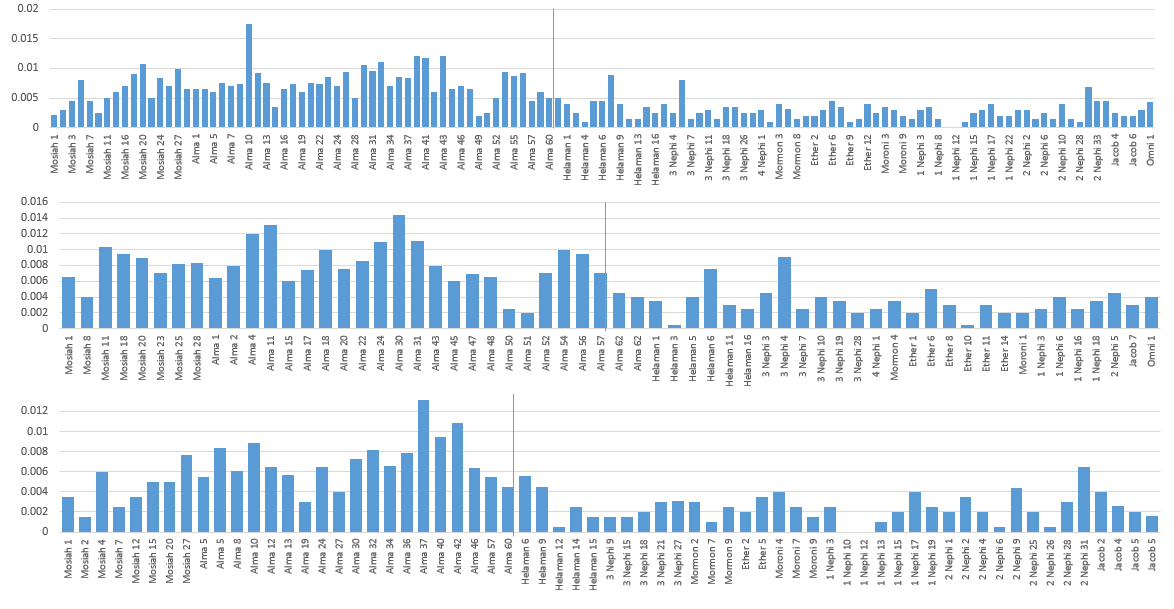

Conclusions
I’m still not ready to give any conclusions. I have a few ideas of ramifications of this on the main BOM authorship theories, that I will provide in a future post. For now, I am trying to demonstrate the strong trends of the Three Voice Hypothesis.